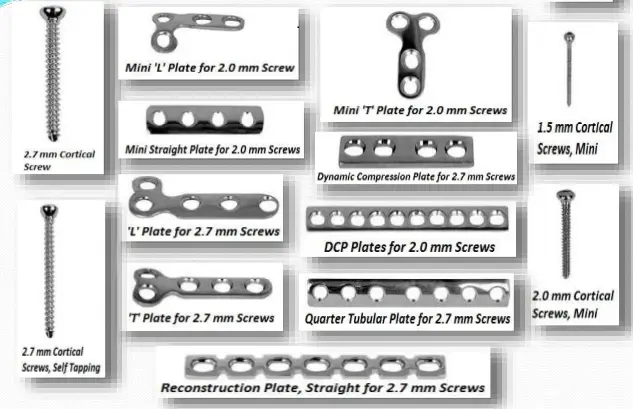Types of Mini Fragment Implants: Choosing the Right Option for Your Fracture

Introduction
In the world of orthopedic surgery, the importance of precision and innovation cannot be overstated. When it comes to treating fractures, especially those that are small or intricate, mini fragment implants have revolutionized the field. Capsur Enterprises, a leading player in the orthopedic implant industry, offers a wide range of mini fragment implants, each designed to address specific fracture types and patient needs. In this blog, we'll delve into the various types of mini fragment implants available at Capsur Enterprises, helping you make an informed decision when it comes to your fracture treatment.
1. Mini Fragments Locking Compression Implants
Locking plates are a staple in the world of mini fragment implants. They offer remarkable stability and are particularly well-suited for fractures that require absolute fixation. These plates are designed with specialized screw holes that allow for a locking mechanism, preventing screws from loosening over time.
One of the key advantages of locking plates is their versatility. They come in various shapes and sizes, making them suitable for a wide range of fractures, from simple to complex. Capsur Enterprises offers locking plates with different angles and lengths, ensuring that surgeons can choose the perfect fit for each unique case.
Capsur Enterprises offers Locking Compression Implants in the form of plates and screws. Some of the implants that they offer are: Screw Locking Cancellous Screw (Full Thread), Locking Distal Dorsal Radius (L-Plate, Oblique L-Plate, T-Plate), Locking Extra Articular Volar Distal Radius (type 1, type 2), Locking Volar Column Distal Radius, Locking Volar Buttres Plate, Locking Volar Column Distal Radius, Locking Distal Volar Variable Angle
2. Mini Fragments Implants
Non-locking plates are another essential option for treating fractures with mini fragment implants. While they may not provide the same degree of stability as locking plates, they offer advantages in specific scenarios. Non-locking plates are ideal for fractures that require a bit of dynamic compression to stimulate bone healing. They allow for some movement at the fracture site, which can encourage the formation of callus, aiding the healing process.
Capsur Enterprises offers non-locking plates in various sizes, allowing surgeons to select the appropriate plate for their patients' needs. These plates are often chosen when preserving some mobility at the fracture site is crucial for optimal recovery.
Some of the Mini Fragment Implants that Capsur Enterprise has to offer are: Cortex Screw, Straight Plate with gap, L Plate, Straight Plate (continue holes), Orbital Plate with and without gap, L Plate (2-3 holes), T Plate (2 holes), X Plate, Y Plate, Z Plate, Straight Recon Plate, Angled Recon Plate, Mandible Recon Plate, Recon Plate (round hole), DCP plate, and Condylar Plate.
3. Screw Options
In addition to plates, screws play a vital role in mini fragment implants. Capsur Enterprises offers a wide range of screws, including cortical screws, cancellous screws, and self-tapping screws. Each type of screw has specific applications, depending on the fracture type and bone density.
- Cortical screws are designed to anchor and stabilize bone fragments or implants in the cortical, or outer, layer of bone tissue. Cortical screw threads are designed to contact cortical bone and provide stability by resisting withdrawal pressures.
- Cancellous screws are designed specifically for use in the spongy, less dense, and trabecular bone tissue, commonly found at the ends of long bones, such as the femur and the tibia. This type of bone is also known as “cancellous” or “spongy” bone.
The ability to choose the right type of screw is critical for achieving optimal outcomes in fracture treatment.
Choosing the Right Mini Fragment Implant
Now that we've explored the various types of mini fragment implants available at Capsur Enterprises, how do you go about selecting the right one for your fracture? Here are some key factors to consider:
1. Fracture Type: The nature and location of the fracture are critical. Is it a simple fracture, a comminuted fracture, or one near a joint? Consult with your orthopedic surgeon to determine the most appropriate implant.
2. Bone Quality: The density and quality of the bone also play a role in implant selection. Dense cortical bone may require locking plates and screws, while softer cancellous bone might benefit from non-locking plates and compression screws.
3. Patient-Specific Factors: Your age, overall health, and activity level are important considerations. Pediatric patients may benefit from biodegradable implants, while active adults might require more robust solutions.
4. Surgeon's Expertise: The experience and preference of your orthopedic surgeon are significant factors in the decision-making process. Trust their expertise and recommendations.
Conclusion
In the realm of orthopedic surgery, the availability of diverse mini fragment implants at Capsur Enterprises offers patients and surgeons an array of choices to address fractures with precision and efficacy. The selection of the right implant should be a collaborative decision between you and your orthopedic surgeon, taking into account the specific characteristics of your fracture, bone quality, and long-term goals.
Whether it's locking implants, non-locking implants, screws, or cutting-edge options like biodegradable or patient-specific implants, Capsur Enterprises' commitment to innovation ensures that you have access to the most advanced solutions in fracture treatment. By working closely with your medical team, you can make an informed choice that sets you on the path to a successful recovery and a healthier, more active life.
05-10-2023

